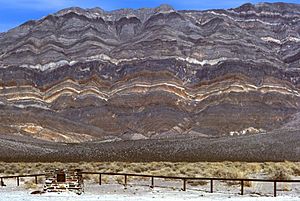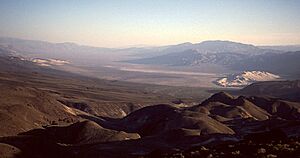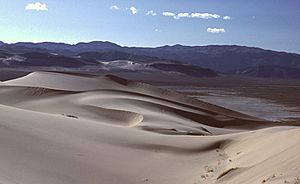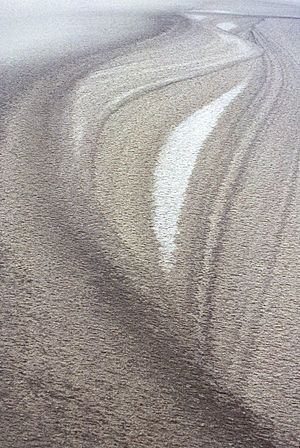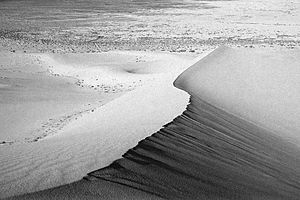Eureka Valley (Inyo County) facts for kids
Eureka Valley is a long, narrow valley located in Inyo County, in eastern California. It's in the southwestern United States. The valley is about 28 miles (45 km) long and up to 10 miles (16 km) wide. Its elevation changes a lot, from 2,870 feet (875 m) to 8,456 feet (2,575 m).
The southern part of Eureka Valley is now part of the Death Valley National Park. Death Valley itself is just to the southeast. To the north, you'll find Deep Springs Valley, Fish Lake Valley, and the White Mountain Range. To the east, the Last Chance Range rises over 5,500 feet (1,675 m) above the valley floor. The Saline Mountains are to the west, and Saline Valley is to the southwest.
Eureka Valley is a type of sunken land called a graben. Many other low-lying areas in the Basin and Range Province are also grabens. A gravel road crosses the valley, connecting the town of Big Pine to the northern part of Death Valley. Another 10-mile gravel road leads to the southern end of the valley. There are also less-used dirt roads that leave the valley in different directions.
The valley has two very special features. Its shape makes the wind collect sand near its southern end. This creates the unique Eureka Dunes. Just east of the dunes, the Last Chance Range climbs over 3,500 feet (1,070 m) as tall, steep cliffs. These cliffs show off colorful layers of rock called strata.
Eureka Sand Dunes
The Eureka Valley Sand Dunes are found in the southern part of Eureka Valley. Even though they only cover about 3 square miles (8 km2), these dunes rise roughly 680 feet (207 m) above the valley floor. This makes them one of the tallest dune fields in North America.
Eureka Valley is a structural valley shaped by the earth's movements. It runs from northwest to southeast. The Last Chance Range is to the east, and the Saline Range is to the west. The Eureka Dunes themselves are in the very southeastern tip of the valley. They run north to south, next to the Last Chance Range. Scientists say the surrounding mountains have very old rocks from the Mississippian and Cambrian periods. The sand on the valley floor is mostly from the more recent Quaternary period.
These dunes are also known as booming sand dunes. Only about forty places in the world have dunes that "boom."
You can reach the dunes by a gravel road in Eureka Valley. This road connects to another road running from Big Pine to the Grapevine section of Death Valley. The dunes became part of the Death Valley National Park when it expanded in 1994. You can walk on the dunes, but vehicles are not allowed. There is a simple campground at the north end of the dune field.
Other sand dunes exist in Death Valley near Stovepipe Wells. The Eureka Dunes are similar in some ways to the Kelso Dunes in the Mojave Desert.
How the Dunes are Shaped
The Eureka Dunes are a mix of different dune types. The main ridge is a steady linear dune. On top of this, there are active star dunes. A linear dune has slopes on both sides of its top. This means the wind must have blown from both the northern and southern ends of the valley to shape it. Star dunes have "arms" that spread out from a central point. These arms change direction as the wind changes.
Scientists don't know much about how the Eureka Dunes formed over time. The source of the sand is also a mystery. Some scientists think it came from an ancient lake at the northern end of the valley.
Why the Dunes "Sing"
The special booming sound of the Eureka Dunes happens when sand grains move against each other. People have compared the sound to moans, hums, drums, or even a distant airplane. For dunes to boom, the sand grains usually need to be small, all about the same size, and very dry. They also need to be loosely packed, and each grain should be round and smooth.
The booming sound occurs when a sheet of sand slides down the dune's face. This movement makes the sand grains vibrate. The rubbing between these grains creates a sound wave in the air that you can hear.
Special Plants and Animals
The Eureka Dunes are home to several unique and protected plant species. The Eureka Dune Grass (Swallenia alexandrae), the Eureka Evening Primrose (Oenothera californica eurekensis), and the Shining Locoweed (Astragalus lentiginosus micans) are only found in this area.
Visitors to the dunes might also notice other interesting things besides the booming sound. When the weather is wet, you can see patterns in the sand. These patterns show how different sources of sand and complex wind processes have shaped the dunes. Scientists are still learning about how these dunes are formed and changed over time.


